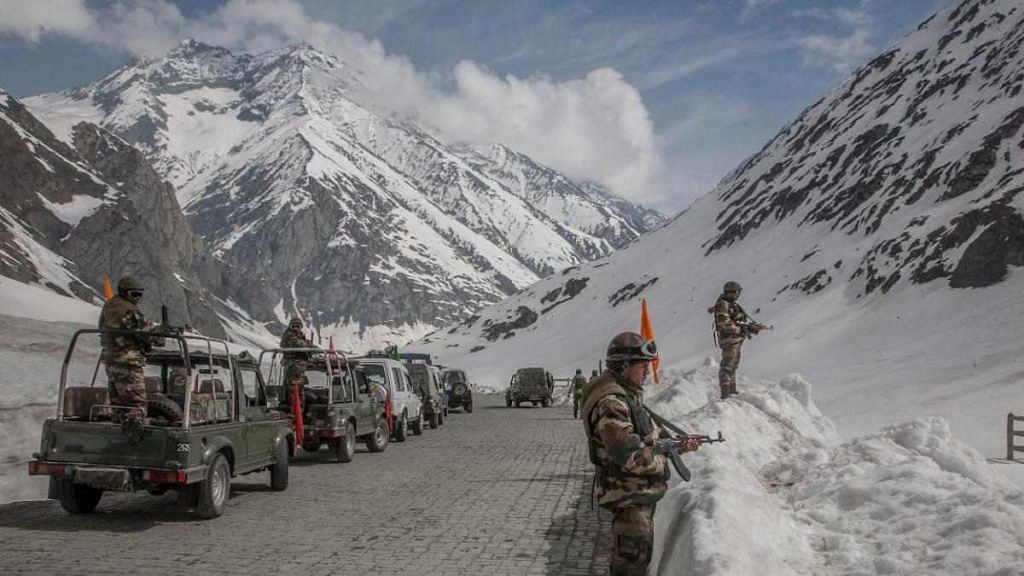New Delhi: India and China are inching closer to a possible resolution of the seven-month military standoff in Eastern Ladakh with both sides contemplating a common proposal to ease tensions, especially along the northern and southern banks of Pangong Tso, ThePrint has learnt.
Government sources said India is hopeful of a “complete disengagement” before the middle of next month and that talks will continue at “all levels”.
The developments come as the icy-cold winters settle in Ladakh with temperature already dropping down to minus 20 degrees Celsius.
According to the proposal, modalities of which are yet to be worked out in detail, the Chinese will move back from the Finger 4 area of the northern banks of Pangong Tso to beyond Finger 8, sources in the defence and security establishment said, adding that the Chinese will also remove all tents and observation posts set up in an 8-km area.
Similarly, Indian troops will also move back to its administrative Dhan Singh Thapa post, which is ahead of Finger 2, but just short of Finger 3, the sources said.
The area from Finger 3 to Finger 8 is likely to remain out of bounds for patrolling by both sides as of now, which is akin to creation of a buffer zone.
The Chinese had earlier agreed to go back from Finger 4 to Finger 5 and make Finger 4 a no-go area. However, the sources said the Chinese are now open to going back beyond Finger 8, which India claims as the LAC.
India and China both claim the area between Finger 2 and Finger 8. Chinese had in May this year moved until the Finger 4 and occupied 8 km of Indian territory.
“This is just a proposal, which is being considered, and not an agreement. The modalities are yet to be worked out as to how many (troops, equipment) will go back and till where. However, the good thing is that Chinese are flexible and open to discussion on all friction points,” a source said.
Government sources said the final points on the disengagement proposal are still being worked out at the military as well as diplomatic levels. They added that India is insistent on “status quo ante and complete disengagement”.
Also read: Here is why US changed Rajnath Singh’s statement on ‘reckless aggression’ by China
‘Verification process has to be foolproof’
Sources said the proposal under consideration includes the pullback of armoured elements like tanks and armoured personnel carriers, besides artillery elements that were moved forward. These include those armoured elements that were moved into the southern banks of Pangong Tso.
The sources indicated that the distance of pullback by both troops could vary as Indians face a tougher terrain than the Chinese, and it would take more time for them to come back than the People’s Liberation Army.
The proposal also involves the Indian troops pulling back from the heights in the southern banks that it had occupied on the intervening night of 29-30 August. These heights include those occupied in the Rezang La area.
While China is demanding that Indian troops immediately vacate the strategic heights, India is insisting on a “gradual pullback”.
China too will pull back from areas like ‘Black Top’ near the southern banks, which it had occupied, sources said.
“The next round of talks will focus on working out the modalities, the disengagement and verification on the ground. What happened on 15 June in Galwan Valley during the disengagement process is on everybody’s mind and, hence, the verification process has to be foolproof,” a second source said, adding that face-to-face meetings by groups of soldiers concerned will be held, and Unmanned Aerial Vehicles will be used.
Army chief General M.M. Naravane had Tuesday said he was hopeful that the Indian and Chinese militaries will be able to reach an agreement.
Depsang Plains issue may stay on for longer
Asked about disengagement from areas like the Gogra post and areas of friction like Galwan Valley, the second source said: “There were agreements reached at most of these locations. However, at some places, the Chinese did carry out their commitments completely, while in certain places it did not.”
“The contentious part was always the northern banks of Pangong Tso and then later the southern banks.”
Asked about the contentious Depsang Plains, the source said the issue pertained to a situation, which had developed much before the current standoff.
“The Chinese have agreed to discuss all friction points, which also include the Depsang Plains that has a different history in comparison to what happened from May onwards,” the source said, indicating the issue would linger on for longer.
Also read: China agrees to discuss all friction points with India, next round of talks could be this week
